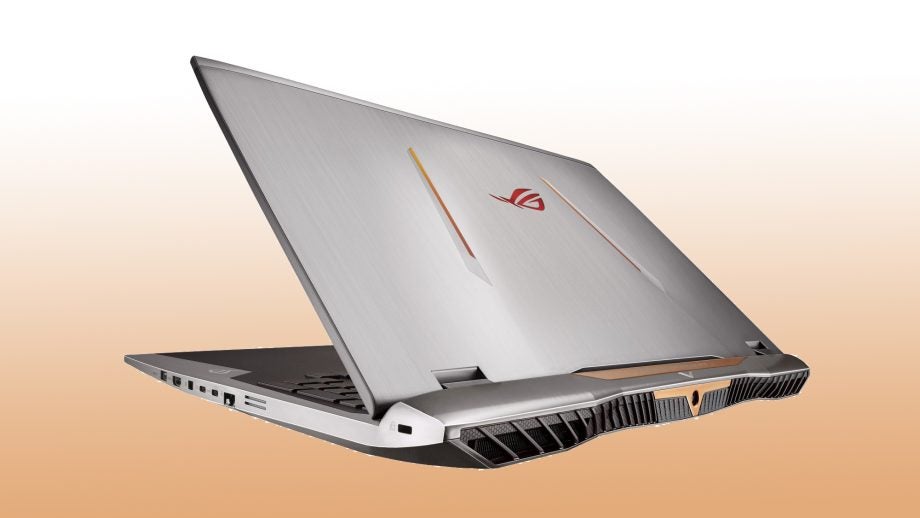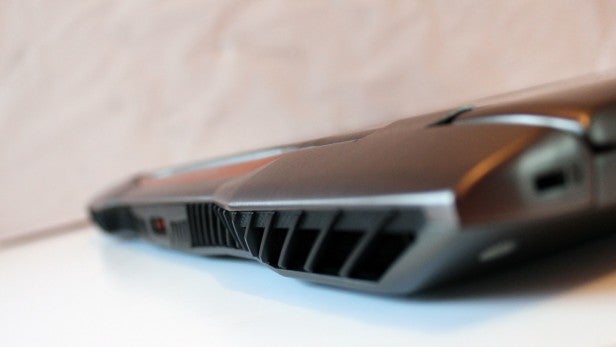Asus ROG G701VI Review
Asus ROG G701VI
Nearly £3,000 for a laptop? This'd better be good

Sections
- Page 1 Asus ROG G701VI Review
- Page 2 Performance, Screen and Sound Review
Verdict
Pros
- Rapid GTX 1080 performance
- Overclockable CPU
- Fast dual SSDs
- High-quality G-Sync screen
- Great design
Cons
- Underwhelming keyboard
- Expensive for the spec
Key Specifications
- Review Price: £2900.00
- 2.7GHz Intel Core i7-6820HK processor
- Nvidia GeForce GTX 1080 8GB graphics
- 17.3in 1,920 x 1,080 IPS 120Hz Nvidia G-Sync screen
- 64GB 2,400MHz DDR4 memory
- 2 x 512GB Toshiba XG3 SSDs
- Windows 10 64-bit
- 2yr RTB warranty
- 3.8kg
What is the Asus ROG G701VI?
Every gaming laptop manufacturer has tried to cram more power inside slim designs with smaller screens, but the best mobile gaming experiences are still found inside larger laptops like the Asus ROG G701VI.
This 17.3-inch beast deploys an Nvidia GeForce GTX 1080, an Intel Core i7 processor and a 120Hz G-Sync screen, and it’s on a mission to provide an unrivalled mobile gaming experience. And, in some ways, it succeeds.
Related: Best PC Games to play on your gaming rig
Asus ROG G701VI – Features
The efficient Nvdia Pascal architecture means there’s barely any difference between the desktop and mobile versions of the GTX 1080 – both have 2,560 stream processors, 7.2 billion transistors and 8GB of super-fast GDDR5X memory. 
The mobile version has a slightly lower clock speed by default, but in this laptop it’s actually been boosted ever so slightly.
That’s in Standard mode – the G701VI has an Extreme option, too. Impressively, that mode sees the GPU clocks improve to 1,622MHz and 1,811MHz. Both of those are better than the desktop core, meaning you’re not losing an ounce of performance by playing on a laptop versus a PC.
Video: How to choose a laptop in 2017
The GPU isn’t the only part that uses this machine’s Standard and Extreme options. The Intel Core i7-6820HK processor is a quad-core mobile processor with an unlocked multiplier, which means it can be overclocked. In Standard mode the 2.7GHz chip boosts to a modest peak of 3.2GHz, but in Extreme mode that improves to 3.8GHz – beyond Intel’s top speed for this part.
Related: Intel Core i processors explained
The rest of the G701VI’s specification is monstrous. This is the first time I’ve reviewed a laptop with 64GB of DDR4 memory, which is frankly overkill, and 953GB of storage comes from two high-end 512GB Toshiba SSDs in RAID 0.
The only underwhelming area is connectivity: this near-£3,000 machine has standard 802.11ac Wi-Fi and Gigabit Ethernet, with no sign of gaming-focused Qualcomm Killer hardware. It’s certainly not a must-have, but still a noticeable omission.
This mighty specification brings the £2,880 Asus up against the Scan 3XS LG17 Carbon Extreme, which is a similarly chunky 17.3-inch notebook that also has a GTX 1080, but it pairs it with a desktop i7-6700K processor.
The Scan has a more sensible 16GB of memory and an SSD and HDD setup, and it costs £2,550. For what it’s worth, you can’t configure that machine with 64GB of memory, so if that’s something you want, the ROG on test here is a better bet.
Sadly, there are no alternative specifications for the G701VI, so if you don’t like these components, that’s it.
Related: Best Gaming Laptops
Asus ROG G701VI – Design
The 17.3in Asus is one of the most outlandish gaming laptops around. Coming from the Republic of Gamers range, though, that’s hardly a surprise.
The thin screen has a huge logo and burnt orange slashes amid its brushed aluminium, and the area above the keyboard is a mix of more orange metal, Mayan-inspired patterns and an angled power button.
The wrist-rest is a mix of aluminium and matte black plastic, the base has more Mayan artwork, and the beefy rear is covered with air vents.
It certainly stands out more than the Scan, which was a modest machine made from dark metal. There’s no winner or loser here – design is subjective and both of these machines impress in their own ways.
It’s easier to draw conclusions in other departments. The Asus weighs 3.8kg and is 35mm thick, which makes it thinner and lighter than the 39mm, 4.3kg Scan. However, the Asus is a little weaker – the screen is easy to bend, and there’s give in the wrist-rest. The Asus is still strong and I’m confident that it would shrug off being tossed in a bag and taken to a LAN party, but the Scan is positively bomb-proof.
There’s another area where the Asus falls behind: interior access. It’s difficult to get inside the Asus, and cracking this machine open voids the warranty. Scan’s machine was easily accessible, and replacing easy-to-access components such as the RAM won’t void the warranty.
Related: Best Laptops Round-up
Asus ROG G701VI – Keyboard and Trackpad
Asus has installed a streaming button, five macro keys and even a switch to open its gaming software on this laptop, and the layout is good elsewhere: full-size keys, separated cursor buttons and a numberpad are all included.
That’s a good start, but the chiclet keyboard can’t keep up the air of quality. It’s one of the softest I’ve used on a large gaming laptop, with a comfortable, squashy feel, modest travel and middling base strength. It’s good for typing, but less so for gaming.
The Scan 3XS LG17 Carbon Extreme had a traditional keyboard that’s much better for gaming despite its lack of macro keys: its buttons are snappier, with more travel and a firmer base.
It’s a shame that the keyboard is a little underwhelming, because the trackpad is much better. It’s wide and smooth, with two high-quality buttons that have good speed and snap. Asus even includes its own USB mouse with this laptop, and it’s even closer to the speed and shallow click that I expect from the best gaming mice. This is a nice addition.
How we test laptops
Unlike other sites, we test every laptop we review thoroughly over an extended period of time. We use industry standard tests to compare features properly. We’ll always tell you what we find. We never, ever, accept money to review a product.


